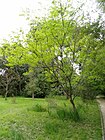Note: This is a project under development. The articles on this wiki are just being initiated and broadly incomplete. You can Help creating new pages.
Sapindus mukorossi
Sapindus mukorossi is a deciduous tree with a globose crown. It usually grows up to 12 metres tall, but can reach up to 25 metres. The straight, cylindrical bole can be 60cm in diameter. The plant has been used by local peoples for thousands of years as a source of saponins that can be used for cleaning clothes etc. It is also harvested from the wild for local use as a food, medicine and source of materials. The tree is often cultivated in gardens, by temples and along roadsides in China and the Indian subcontinent, both as an ornament and also as a source of soap and as a medicine. The seeds are commonly sold in local markets.
Contents
- 1 Uses
- 2 Parts Used
- 3 Chemical Composition
- 4 Common names
- 5 Properties
- 6 Habit
- 7 Identification
- 8 List of Ayurvedic medicine in which the herb is used
- 9 Where to get the saplings
- 10 Mode of Propagation
- 11 How to plant/cultivate
- 12 Commonly seen growing in areas
- 13 Photo Gallery
- 14 References
- 15 External Links
Uses
Parts Used
Chemical Composition
The major constituents of Sapindus mukorossi fruit are saponins (10%-11.5%), sugars (10%) and mucilage10. Saponins are secondary plant metabolites with divergent biological activities.[2]
Common names
| Language | Common name |
|---|---|
| Kannada | |
| Hindi | Phenil |
| Malayalam | |
| Tamil | |
| Telugu | |
| Marathi | Phenil |
| Gujarathi | |
| Punjabi | |
| Kashmiri | |
| Sanskrit | Hrishtah |
| English | Reetha, Chinese Soapberry |
Properties
Reference: Dravya - Substance, Rasa - Taste, Guna - Qualities, Veerya - Potency, Vipaka - Post-digesion effect, Karma - Pharmacological activity, Prabhava - Therepeutics.
Dravya
Rasa
Guna
Veerya
Vipaka
Karma
Prabhava
Habit
Identification
Leaf
| Kind | Shape | Feature |
|---|---|---|
Flower
| Type | Size | Color and composition | Stamen | More information |
|---|---|---|---|---|
| {{{5}}} |
Fruit
| Type | Size | Mass | Appearance | Seeds | More information |
|---|---|---|---|---|---|
Other features
List of Ayurvedic medicine in which the herb is used
Where to get the saplings
Mode of Propagation
How to plant/cultivate
A plant of the subtropical to the tropical zone, where it can be found at elevations up to 1,500 metres. It is found in areas where the mean annual rainfall is around 1,750mm.[4]
Commonly seen growing in areas
Photo Gallery
References
- ↑ Indian Medicinal Plants by C.P.Khare
- ↑ Chemical constituents
- ↑ [Morphology]
- ↑ Cultivation
External Links
- Ayurvedic Herbs known to be helpful to treat Burns
- Herbs with Seeds used in medicine
- Herbs with common name in Hindi
- Herbs with common name in Marathi
- Herbs with common name in Sanskrit
- Herbs with common name in English
- Habit - Deciduous tree
- Index of Plants which can be propagated by Seeds
- Index of Plants which can be propagated by Greenwood cuttings.
- Herbs that are commonly seen in the region of Open rocky places
- Herbs




